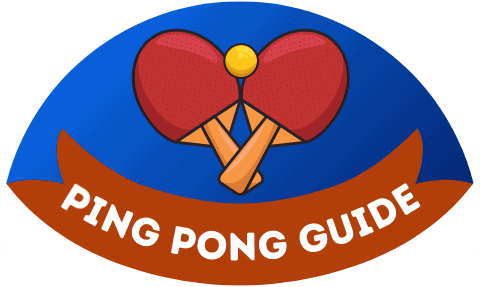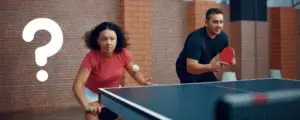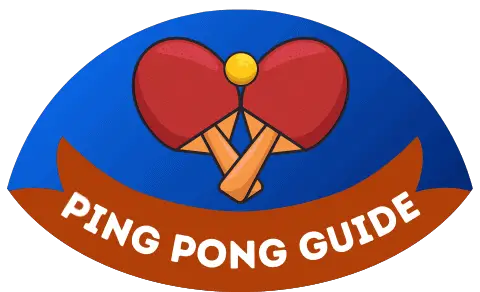Have you ever had that moment when you couldn’t explain why a shot just went out of bounds or into the net? You even had a good feeling about the shot? The reason is that you did not react correctly to the spin of your opponent. Learn how to do that and how to put your opponent in that situation yourself in this post.
Spin, in other words, the rotation of the ball, ensures a stable trajectory. If the ball would not spin, it would “flutter” in an inconstant trajectory. You may know this from Football. In table tennis, this is rather rare. Most of the time, you also unconsciously give the ball a certain spin.
However, the skillset of a table tennis player, of course, includes consciously using the 3 different types of spin, mastering them, and using them at the right moments to put the opponent under pressure or to counter his strokes.
What Types of Spin are There?
If you picture it, you understand well why we generally speak of 3 types of spin. A ball can spin forwards, backwards, and sideways. In table tennis (and other racket sports) we speak of:
- Topspin (overcut) – Forward rotation of the ball
- Backspin (undercut) – Backward rotation of the ball
- Sidespin (side cut) – Sideward rotation of the ball
But enough theory, let’s get to the practical side. So how do you hit the ball correctly for these techniques and how do you react correctly to spin? I will explain that to you now:
How to Hit a Topspin Shot?
Topspin is the most important attacking stroke in table tennis. The goal is to give the ball a forward rotation. To do this, you tilt the paddle forward (this is also called the closed racket angle) and brush it over the ball from a low to a high position.
How much spin you give the ball depends on how much you tilt the bat, where you hit the ball, and how fast you execute the movement.
What is the Effect of Topspin?
By rotating forward, the ball’s trajectory shortens and it hits the table earlier and more steeply. After contact with the table, the ball bounces in a flatter curve. In addition, it accelerates once again. This makes topspin the perfect attacking stroke.
If a topspin is blocked with a neutral racket position (i.e. without a tilt), the ball bounces off it in a high arc. As a result, the opponent is likely to play a ball that goes wide or bounces very high. So you can hit the next attacking shot.
But how do you counter topspin when you are on defense? How do you prevent the ball from bouncing out or back in a high arc?
How to Counter Topspin?
In general, there are two ways to counter a topspin attack:
- If you stand close to the table, you again tilt the racket forward (closed angle) to counteract the high bounce. So you play topspin yourself.
The more spin the ball has, the more you have to tilt the paddle. It is therefore important to interpret your opponent’s movement correctly.
- To block attacking shots, you often take a few steps away from the plate. This way you have a longer reaction time and can return the ball in a more controlled way. In this situation, you play the ball with an undercut in a higher arc.
What are the Advantages of Topspin?
The trajectory of topspin balls brings some advantages. First, the ball bounces a little higher off the racket and drops down steeper behind the net.
- The danger of hitting the net is reduced
- Fast balls do not fly as far, because the trajectory is shortened
- You put the opponent under pressure
How to Hit a Backspin Shot?
Backspin is essential for controlled balls and especially on serve. It is precisely the opposite rotation of the topspin. The movement to generate it is therefore also exactly the opposite. To hit the ball with a backward spin, you have to tilt the racket backward (open angle).
You move the paddle from the top down and touch the ball on the underside. This is where the name undercut comes from.
What are the Effects of Backspin?
Because of the backspin, it sometimes looks like the ball is slightly hovering. When it touches the table, it slows down due to the backspin and doesn’t fly as far. With extreme undercut, it can even happen that the ball changes direction on contact with the table.
Backspin often makes a ball unpredictable and is therefore very often used on serves. Thus, it is crucial to know how to counter that spin properly, otherwise, you won’t get into the game at all.
If you return a backspin ball with a neutral racket position, again the opposite happens as with topspin. That is, the ball bounces off the racket in a downward direction. So you are more likely to play the ball into the net.
How do You Counter Backspin?
To counteract that the ball bounces too short, you have to give it some upward movement. There are two ways to do this:
Again, you undercut the ball meaning you counter it with backspin.
You return the ball with a neutral or even slightly closed angle. However, you have to make a slight upward stroke movement.
What are the Advantages of Backspin?
Backspin…
- provokes mistakes of the opponent
- counters most serves
How to Hit a Sidespin Shot?
Cutting the ball sideways provides a rotation to the side. To do this, you pull the bat past either the right or left side of the ball. The movement is similar to backspin, except that you tilt the club to the side.
What are the Effects of Sidespin?
If you cut the ball sideways, the ball travels in a curve. If you cut it on the right side, it travels to the left and vice versa. This additional dimension, which is added to a shot, makes it even more difficult to find the right answer.
If you block a sidespin ball with a neutral angle, it bounces in the opposite direction, analogous to backspin.
How do you Counter Sidespin?
With the right sidespin, the ball bounces off the racket further to the left. To counteract this, aim your next shot a little further to the right. You could also counter with right sidespin.
With left sidespin, it is exactly the opposite. That means you play the ball a bit further to the left or answer with left sidespin.
If you are not sure in which direction the ball is spinning, it is best to aim for the middle.
How do You Tell the Spin of the Ball?
In theory, it sounds quite simple: as a counter, you counteract the effect of the respective spin. But how do you recognize in a split second during a rally in which direction the ball is spinning?
Since the spin is related to the speed with which the ball is struck, it is important to observe the opponent’s movement. Furthermore, you can recognize the different types of spin, by the way, the ball bounces. Here, of course, you have to react very quickly.
Reading the spin is one of the most challenging skills to master. Over time, your understanding of it gets better and better, and you almost automatically adapt the racket to the specific situation.
Better Understand Spin with this Method
In order to intuitively use spin correctly, it is important to internalize the effect. One trick I discovered for myself is the playback mode. This is the mode when you set up one side of the table tennis table (most tables allow this).
If you now play against the upright half with spin, you can see exactly what effect the respective cut type has. This helped me to quickly understand how I have to hold my racket to return cut balls.
Which Effect does the Rubber have on the Spin?
A quick word about the influence of the rubber on the spin. My explanations have mainly referred to the most commonly played inverted, smooth rubber. With this rubber, the ball can be cut well and in all directions.
However, there are also other types of rubbers where the situation is different. For example, if the pimples of the rubber point outwards, the ball cannot be cut so well. However, the effects of the opponent’s spin are no longer as strong. The longer the pimples are, the less effect the spin has.
Then there is the anti-spin rubber. This is similar to the smooth rubber with pimples on the inside, except that it has a very slippery surface, without any grip, like on old table tennis bats (you can find out how to make them sticky again here).
Anti-Spin rubber neutralizes the opponent’s spin. You can’t really generate spin yourself. With this rubber, it is all about playing the ball controlled and placed.
Now it’s Your Turn!
I hope I was able to explain to you how to generate your own spin on your shots and how to respond correctly to your opponent’s spin. If you master this, you are already playing at a very advanced level.
It really takes time and experience to get the hang of it. The most important thing is, as always, that you have fun!





